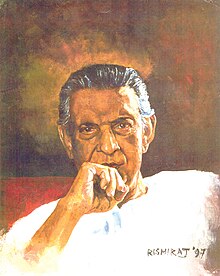
Satyajit Ray (; 2 May 1921 – 23 April 1992) was an Indian filmmaker who worked prominently in Bengali cinema and who has often been regarded as one of the greatest and most influential directors in the History of cinema.[1] Ray was born in Calcutta (now Kolkata) to a Bengali family and started his career as a junior visualiser.[2] His meeting with French film director Jean Renoir, who had come to Calcutta in 1949 to shoot his film The River (1951), and his 1950 visit to London, where he saw Vittorio De Sica's Ladri di biciclette (Bicycle Thieves) (1948), inspired Ray to become a film-maker.[3][4] Ray made his directorial debut in 1955 with Pather Panchali and directed 36 films, comprising 29 feature films, five documentaries, and two short films.
Although Ray's work generally received critical acclaim,[5][6] his film Pather Panchali and Ashani Sanket (1973) were criticised for "exporting poverty" and "distorting India's image abroad".[5][7] His Apu Trilogy (1955–1959) appeared in Time's All-Time 100 Movies in 2005.[8] Aside from directing, Ray composed music and wrote screenplays for films, both his own and those by other directors.[9] Often credited as a fiction writer, illustrator, and calligrapher; Ray authored several short stories and novels in Bengali, most of which were aimed at children and adolescents.[10][11] Some of his short stories have been adapted into films by other directors, including his only son, Sandip Ray. Considered a cultural icon in India and acknowledged for his contribution to Indian cinema,[12] Ray has influenced several filmmakers around the world, including Wes Anderson, Martin Scorsese,[13][14] James Ivory,[15] François Truffaut,[16] Carlos Saura,[17] and Christopher Nolan.[18]
Ray intended to make various other films, including The Alien, whose early script is sometimes said to have inspired Steven Spielberg's 1982 film E.T.;[19][20] a documentary on Indian sitar player Ravi Shankar;[21] an adaptation of the ancient Indian epic, the Mahābhārata; and an adaptation of E. M. Forster's 1924 novel, A Passage to India. However, none had been started when he died in 1992.[22]
Ray received numerous awards at international film festivals and elsewhere, including several Indian National Film Awards and an honorary Academy Award at the 64th Academy Awards in 1992.[23] Ray was awarded India's highest award in cinema, the Dadasaheb Phalke Award, in 1984 and India's highest civilian award, Bharat Ratna, in 1992.[24][25]
- ^ "Sight and Sound Poll 1992: Critics". California Institute of Technology. Archived from the original on 18 June 2015. Retrieved 3 February 2013.
- Kevin Lee (5 September 2002). "A Slanted Canon". Asian American Film Commentary. Archived from the original on 31 May 2012. Retrieved 3 February 2013.
- "Greatest Film Directors and Their Best Films". Filmsite.org. Archived from the original on 19 April 2015. Retrieved 3 February 2013.
- "The Greatest Directors Ever by Total Film Magazine". Filmsite.org. Archived from the original on 26 April 2014. Retrieved 3 February 2013.
- ^ Robinson 1989, pp. 56–58.
- ^ Robinson 1989, pp. 42–44.
- ^ Robinson 1989, p. 48.
- ^ a b Malcolm, Derek (2 May 2002). "The universe in his backyard". The Guardian. London. Archived from the original on 15 January 2015. Retrieved 3 February 2013.
- ^ Swagrow, Michael (28 September 1994). "An art wedded to truth". The Atlantic. Archived from the original on 31 May 2015. Retrieved 3 February 2013.
- ^ Ganguly 2010, pp. 6–7.
- ^ Schickel, Richard (12 February 2005). "Time 100: The Apu Trilogy". Time. Archived from the original on 20 October 2013. Retrieved 3 February 2013.
- ^ Robinson 1989, pp. 352–364.
- ^ "Books written by Satyajit Ray". satyajitray.org. Archived from the original on 30 March 2013. Retrieved 4 February 2013.
- ^ Robinson 1989, pp. 296–305.
- ^ Tankha, Madhur (1 December 2007). "Returning to the classics of Ray". The Hindu. New Delhi. Archived from the original on 26 April 2014. Retrieved 3 February 2013.
- ^ "Scorsese's secret inspiration". ShortList. Archived from the original on 10 March 2013. Retrieved 3 February 2013.
- ^ "Martin Scorsese hits DC, hangs with the Hachet". The GW Hatchet. 4 March 2002. Archived from the original on 17 July 2012. Retrieved 3 February 2013.
- ^ "Ivory, James (1928–)". Screenonline. Archived from the original on 30 December 2006. Retrieved 3 February 2013.
- ^ "The 'World' of Satyajit Ray legacy of India's premier film maker on display". Daily News (New York). 5 May 1995. Archived from the original on 21 February 2015. Retrieved 3 February 2013.
- ^ "Satyajit Ray is this Spanish director's inspiration". CNN-IBN. 11 March 2008. Archived from the original on 7 July 2014. Retrieved 3 February 2013.
- ^ "Christopher Nolan: I think Satyajit Ray's Pather Panchali is an extraordinary piece of work". The Indian Express. 1 April 2018. Retrieved 4 March 2023.
- ^ Robinson 1989, pp. 287–295.
- ^ "Close encounters with native E.T. finally real". The Times of India. Kolkata. 5 April 2003. Archived from the original on 23 October 2012. Retrieved 24 March 2013.
- "Satyajit Ray Collection receives Packard Grant and Lecture Endowment". University of California. 18 September 2001. Archived from the original on 13 October 2012. Retrieved 24 March 2013.
- "Ray influenced E.T says Martin Scorsese". The Times of India. 19 May 2010. Archived from the original on 27 March 2014. Retrieved 24 March 2013.
- ^ Dutta, Indrani (13 December 2012). "Satyajit had planned documentary on Pandit Ravi Shankar". The Hindu. Archived from the original on 18 February 2013. Retrieved 3 February 2013.
- ^ Robinson 1989, pp. 284–286.
- ^ "The 64th Academy Awards (1992)". Academy of Motion Picture Arts and Sciences. 30 March 1992. Archived from the original on 23 September 2014. Retrieved 3 February 2013.
- ^ "Dadasaheb Phalke Award past recipients". Directorate of Film Festivals. Archived from the original on 26 May 2016. Retrieved 3 February 2013.
- ^ "List of recipients of Bharat Ratna" (PDF). Ministry of Home Affairs (India). Retrieved 3 February 2013.